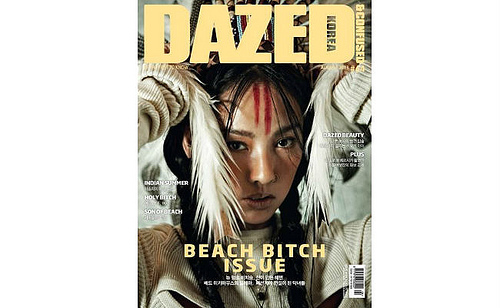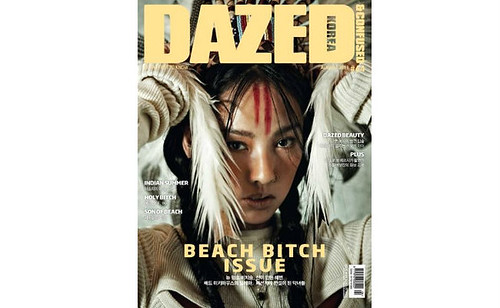As I was making my daily K-Pop news round-up, I couldn’t help but notice a photo of K-Pop diva Lee Hyori’s new cover for Dazed & Confused (Korea). Besides the interesting use wordplay and homonyms on the cover (“Beach Bitch”), what is most striking is the editorial concept used for the cover and accompanying editorial. Hyori is styled with face paint, a head dress and feathers, with her hair in two braids, supposed indicators of “Native American” dress, very reminiscent to Michelle Williams’ cover of AnOther magazine released earlier this year. At least for me, the “Indian Summer” concept (as indicated on the cover and is another issue in and of itself) is taken too literally and crosses the fine line between cultural appreciation and cultural appropriation.
Now, don’t get me wrong, I’m a fan of Hyori; she’s stunning and has an awesome personality (Family Outing, anyone?). It’s just disappointing that the editors of “Dazed” would allow this and that she, or at least her management, would agree to it. An editorial with summertime clothes wouldn’t have sufficed?
For me, the issue with this cover and with many other instances like this, is that traditional cultures are used like thematic costumes, with a lack of understanding about the cultures themselves. The beautiful, rich, and diverse culture of the Native American community is being diluted into a stereotype or simple archetype that assumes homogeneity. Or more simply put, photos and images like these re-emphasize the idea that all Native Americans are the same, which is blatantly inaccurate and culturally insensitive.
But, why does this even matter? It’s just a magazine, right? Well, not exactly. As put best by Metcalfe (Turtle Mountain Chippewa from North Dakota) in an article for Jezebel:
“There isn’t just one Native American culture. There are hundreds. And there are millions of Native people. And we’re being ignored. We’re being told that we don’t have rights over how we are represented in mainstream America. We are being told that we should ‘get over it’ – but the people who are saying this don’t even know what the issues are. When people know of us only as a ‘costume,’ or something you dress up as for Halloween or for a music video, then you stop thinking of us as people, and this is incredibly dangerous because everyday we fight for the basic human right to live our own lives without outsiders determining our fate or defining our identities.”
Though this particular cover is directly related to the Native American community, this is an issue that is not exclusive to them; for years, various cultures, including Asian cultures, have been and continue to be commodified into cultural products for mass consumption, and not necessarily for cultural understanding. Geisha costumes run rampant, Selena Gomez’s stage costume includes a bindi, and that’s just the tip of the metaphorical iceberg, the majority of which can’t be examined in this brief post. But, that difference between using culture as an aesthetic accessory versus using it as a tool for cognizance is what separates what is “okay” from “not okay.” More interestingly and more notably, the Korean cover itself proves that this issue extends much farther than the borders of the US and is a global issue.
Yes, cultural appropriation is a hot-button, sensitive topic. But instances like these remind us of the continued importance of understanding and appreciating other’s histories, cultures and backgrounds for the simple, but powerful reason of respect. And as an increasingly global community, it’s even more important to view cultures, customs and dress that’s different from our own as more than just trend, but as an integral part of someone’s identity and history.








